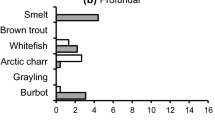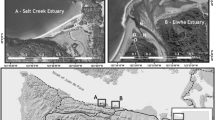Abstract
Fish stranding is a complex phenomenon largely attributed to anthropogenic causes in regulated rivers. Although our knowledge of the frequency of stranding and fate of stranded fish in unregulated rivers is limited, this phenomenon may be widespread and important for the transfer of nutrients from aquatic to terrestrial ecosystems. Using a combination of observational data, an experimental manipulation, and a nitrogen subsidy model, we investigated the fate and implications of fish stranded in off-channel pools created by the last spring flood, in the Kadashan River watershed on Chichagof Island, Alaska, USA. Of fish stranded in pools (exclusively juvenile Dolly Varden Char [Salvelinus malma] and Coho Salmon [Oncorhynchus kisutch]), smaller individuals (age-0; < 74 mm) were more common than larger ones (age-1; > 74 mm). Mortality rate was mainly influenced by cover availability, and larger fish tended to disappear at a higher rate than smaller ones. These observations, together with detection of predator activity, suggest that predation was the main cause of mortality for stranded fish. We estimate that fish stranding occurred during 66% of the years between 1980 and 2015, and that in a single stranding event approximately 1.62 kg of nitrogen is available to predators in the 0.24 km2 floodplain of the Kadashan watershed surveyed. Thus, fish stranding likely has implications for cross ecosystem connectivity via aquatic nutrient transfers to terrestrial food webs. With projected increases in extreme precipitation and flood events in Southeast Alaska the incidence of fish stranding in unregulated rivers will likely increase. Our results suggest by ensuring that cover (e.g. large wood and artificial structures) is available in off-channel habitats to benefit species or populations of conservation concern.




Similar content being viewed by others
References
Alexander GR (1979) Predators of fish in coldwater streams. In: Stroud HR, Clepper H (eds) Predator–prey systems in fisheries management. Sport Fishing Institute, Washington, DC, pp 153–170
Ben-David M (1996) Seasonal diets of mink and marten: effects of spatial and temporal changes in resource abundance. Dissertation, University of Alaska Fairbanks
Ben-David M, Hanley TA, Klein DR, Schell DM (1997) Seasonal changes in diets of coastal and riverine mink: the role of spawning Pacific Salmon. Can J Zool 75:803–811
Ben-David M, Hanley TA, Schell DM (1998) Fertilization of terrestrial vegetation by spawning Pacific salmon: the role of flooding and predator activity. Oikos 1:47–55
Brown RS, Power G, Beltaos S (2001) Winter movements and habitat use of riverine brown trout, white sucker and common carp in relation to flooding and ice break-up. J Fish Biol 59:1126–1141
Bryant MD (1984) The role of beaver dams as Coho Salmon habitat in Southeast Alaska streams. In: Walton JM, Huston DB (eds) Proceeding of the Olympic Wild Fish Conference. Fisheries Technology Program Port Angeles, Washington pp 183–192
Cederholm CJ, Kunze MD, Murota T, Sibatani A (1999) Pacific salmon carcasses: essential contributions of nutrients and energy for aquatic and terrestrial ecosystems. Fisheries 24:6–15
Cott P, Schein A, Hanna B, Johnston T, Mcdonald D, Gunn J (2015) Implications of linear developments on northern fishes. Environ Rev 23:1–14
Cushman RM (1985) Review of ecological effects of rapidly varying flows downstream from hydroelectric facilities. N Am J Fish Manag 5:330–339
Dollof CA (1993) Predation by river otters (Lutra canadensis) on juvenile Coho Salmon (Oncorhynchus kisutch) and Dolly Varden (Salvelinus malma) in southeast Alaska. Can J Fish Aquat Sci 50:312–315
Dollof CA, Reeves GH (1990) Microhabitat partitioning among stream-dwelling juvenile Coho Salmon, Oncorhynchus kisutch, and Dolly Varden, Salvelinus malma. Can J Fish Aquat Sci 47:2297–2306
Dore MH (2005) Climate change and changes in global precipitation patterns: what do we know? Environ Int 31:1167–1181
Gende SM, Edwards RT, Willson MF, Wipfli MS (2002) Pacific Salmon in aquatic and terrestrial ecosystems: Pacific salmon subsidize freshwater and terrestrial ecosystems through several pathways, which generates unique management and conservation issues but also provides valuable research opportunities. Bioscience 52:917–928
Gray LJ (1989) Correlations between insects and birds in tallgrass prairie riparian habitats. In: Bragg T, Strubbendieck JL (eds) Proceedings of the 11th North American Prairie Conference, University of Nebraska, Lincoln, USA, pp 263–265
Grimm NB (1987) Nitrogen dynamics during succession in a desert stream. Ecology 68:1157–1170
Hesthagen T, Hegge O (1992) Stranding of pond- and hatchery-reared juvenile brown trout, Salmo trutta L., during draw-down of a pond. Aquac Res 23:399–403
Hodges SW, Magoulick DD (2011) Refuge habitats for fishes during seasonal drying in an intermittent stream: movement, survival, and abundance of three minnow species. Aquat Sci 73:513–522
Howells WW (1978) Stranded fish as food source for large birds. Honeyguide 96:18
Hughes NF, Dill LM (1990) Position choice by drift feeding salmonids: model and test for Arctic Grayling (Thymallus arcticus) in subarctic mountain streams, interior Alaska. Can J Fish Aquat Sci 47:2039–2048
Hunter CJ (1991) The trout and the stream. In: Palmer T (ed) Better trout habitat: a guide to stream restoration and management. Island Press, Washington D.C., pp 11–67
Hvidsten NA and Trout B (1985) Mortality of pre-smolt Atlantic Salmon, Salmo salar L. Salmo trutta, caused by fluctuating water levels in the regulated river Nidelva, central Norway. J Fish Biol 27:711–718
IPCC (2014) Climate Change 2014: synthesis report. Contribution of Working Groups I, II, III to the fifth assessment report of the intergovernmental panel on climate change. IPCC, Geneva
Kreutzweiser D, Beall F, Webster K, Thompson D, Creed I (2013) Impacts and prognosis of natural resource development on aquatic biodiversity in Canada’s boreal zone 1. Environ Rev 21:227–259
Kroger RL (1973) Biological effects of fluctuating water levels in the Snake River, Grand Teton National Park, Wyoming. Am Midl Nat 89:478–481
Labbe TR, Fausch KD (2000) Dynamics of intermittent stream habitat regulate persistence of a threatened fish at multiple scales. Ecol Appl 10:1774–1791
Lawrence JE, Lunde KB, Mazor RD, Bêche LA, McElravy EP, Resh VH (2010) Long-term macroinvertebrate responses to climate change: implications for biological assessment in mediterranean-climate streams. J N Am Benthol Soc 29:1424–1440
Leigh C, Boulton AJ, Courtwright JL, Fritz K, May CL, Walker RH, Datry T (2015) Ecological research and management of intermittent rivers: an historical review and future directions. Freshw Biol. https://doi.org/10.1111/fwb.12646
Magoulick DD, Kobza RM (2003) The role of refugia for fishes during drought: a review and synthesis. Freshw Biol 48:1186–1198
May CL, Lee DC (2004) The relationship among in channel sediment storage, pool depth, and summer survival of juvenile salmonids in Oregon coast range streams. N Am J Fish Manag 24:761–774
McLoughlin PD, Lysak K, Debeffe L, Perry T, Hobson KA (2016) Density-dependent resource selection by a terrestrial herbivore in response to sea-to-land nutrient transfer by seals. Ecology 97:1929–1937
Murphy ML, Meehan WR (1991) Stream ecosystems. In: Influences of forest and rangeland management on salmonid fishes and their habitats. American Fisheries Society Special publication 19, London, pp 17–46
Murphy ML, Heifetz J, Thedinga JF, Koski KV, Grette GB (1984) A stream ecosystem in an old-growth forest in southeast Alaska. Part V: seasonal changes in habitat utilization by juvenile salmonids. In: Meehan WR, Merrel TR Jr, Hanley TA (eds) Fish and wildlife interactions in old-growth forests. University of Washington, Washington, pp 89–98
Murphy ML, Heifetz J, Thedinga JF, Johnson SW, Koski KV (1989) Habitat utilization by juvenile Pacific Salmon (Oncorhynchus sp.) in the glacial Taku river, southeast Alaska. Can J Fish Aquat Sci 46:1677–1685
Nadeau TL, Rains MC (2007) Hydrological connectivity of headwaters to downstream waters: Introduction to the featured collection. J Am Water Resour As 43:1–4
Nagrodski A, Raby GD, Hasler CT, Taylor MK, Cooke SJ (2012) Fish stranding in freshwater systems: sources, consequences, and mitigation. J Environ Manag 103:133–141
Naiman RJ, Decamps H (1997) The ecology of interfaces: riparian zones. Annu Rev Ecol Syst 621–658
Naiman RJ, Bilby RE, Schindler DE, Helfield JM (2002) Pacific salmon, nutrients, and the dynamics of freshwater and riparian ecosystems. Ecosystems 5:399–417
Neter J, Wasserman W, Kutner MH (1990) Applied linear statistical models, 3rd edn. Richard D. Irwin, Inc., Burr Ridge
Oswood MW, Barber WE (1982) Assessment of fish habitat in streams: goals, constraints, and a new technique. Fisheries 7:8–11
Pollock MM (1995) Patterns of plant species richness in emergent and forested wetlands of Southeast Alaska. Dissertation. University of Washington. Seattle, Washington
Pyke GH, Pulliam HR, Charnov EL (1977) Optimal foraging: a selective review of theory and tests. Q Rev Biol 52:137–154
R Development Core Team (2016) R: a language and environment for statistical computing. R Foundation for Statistical Computing, Vienna
Saltveit SJ, Halleraker JH, Arnekleiv JV, Harby A (2001) Field experiments on stranding in juvenile Atlantic Salmon (Salmo salar) and Brown Trout (Salmo trutta) during rapid flow decreases caused by hydropeaking. Regul Rivers Res Manag 17:609–622
Schlosser IJ (1995) Critical landscape attributes that influence fish population dynamics in headwater streams. Hydrobiologia 303:71–81
Small GE, Duff JH, Torres PJ, Pringle CM (2013) Insect emergence as a nitrogen flux in Neotropical streams: comparisons with microbial denitrification across a stream phosphorus gradient. Freshw Sci 32:1178–1187
Sullivan K, Lisle CA, Dollof GE, Grant GE, Reid LM (1987) Stream channels: the link between forests and fisheries. In: Salo EO, Cundy TW (eds) Streamside management. Forestry and Fishery Interactions University of Washington, Washington, pp 39–97
Swales S, Levings CD (1989) Role of off-channel ponds in the life cycle of Coho Salmon (Oncorhynchus kisutch) and other juvenile salmonids in the Coldwater River, British Columbia. Can J Fish Aquat Sci 46:232–242
Swales S, Lauzier RB, Levings CB (1986) Winter habitat preferences of juvenile salmonids in two interior rivers in British Columbia. Can J Zool 64:1506–1514
Taylor EB, McPhail JD (1985) Variation in burst and prolonged swimming performance among British Columbia populations of Coho Salmon, Oncorhynchus kisutch. Can J Fish Aquat Sci 42:2029–2033
Thedinga JF, Murphy ML, Koski KV (1988) Seasonal habitat utilization by juvenile salmon in the lower Taku river, southeast Alaska. NWAFC Processed Report 88-32. National Marine Fisheries Service, National Oceanic and Atmospheric Administration, December 1988
Thornton PE, Thornton MM, Mayer BW, Wei Y, Devarakonda R, Vose RS, Cook RB (2016) Daymet: daily surface weather data on a 1-km grid for North America, Version 3. ORNL DAAC, Oak Ridge, Tennessee, USA. Accessed Month 02, 2017. (Time period: 1980–01-01 to 2015-01-01. Spatial Range: N = 57.73, Seasonal habitat utilization 135.22, S = 57.60, −135.205, E = 57.679, −135.076, W = 57.671, −135.349)
Walker RH, Adams GL (2014) Ecological factors influencing movement of Creek Chub in an intermittent stream of the Ozark Mountains, Arkansas. Ecol Freshw Fish 25:190–202
Walker RH, Adams GL, Adams R (2012) Movement patterns of southern redbelly dace, Chrosomus erythrogaster, in a headwater reach of an Ozark Stream. Ecol Freshw Fish 22:216–227
Willson MF, Gende SM, Bisson PA (2004) Anadromous fishes as ecological links between ocean, freshwater, and land. In: Polis GA, Power ME, Huxel GA (eds) Food webs at the landscape level. University of Chicago Press, Illinois, pp 284–300
Wood CC (1987) Predation of juvenile pacific salmon by the common merganser (Mergus merganser) on eastern vancouver island. II: predation of stream-resident juvenile salmon by merganser broods. Can J Fish Aquat Sci 44:950–959
Woodward G, Perkins DM, Brown LE (2010) Climate change and freshwater ecosystems: impacts across multiple levels of organization. Philos Trans Roy Soc B 365:2093–2106
Zar JH (2016) Biostatistical analysis. Prentice-Hall Inc., Englewood Cliffs
Acknowledgements
We thank B. Wissing for assistance in collecting data in the field. Drs. T. A. Hanley, M. W. Oswood, and J. Reynolds provided helpful comments on earlier versions of the manuscript. All procedures were approved by an Independent Animal Care and Use Committee at the University of Alaska Fairbanks. Funding for the project was provided by the USDA Forest Service, Pacific Northwest Research Station, Juneau, Alaska. Logistical support was provided by the USDA Forest Service, Pacific Northwest Research Station, Juneau, Alaska, and the Alaska Cooperative Fish and Wildlife Research Unit, University of Alaska Fairbanks.
Author information
Authors and Affiliations
Corresponding author
Rights and permissions
About this article
Cite this article
Walker, R.H., Maitland, B.M., LaSharr, T.N. et al. Fate of juvenile salmonids stranded in off-channel pools: implications for nutrient transfers. Aquat Sci 80, 10 (2018). https://doi.org/10.1007/s00027-017-0562-z
Received:
Accepted:
Published:
DOI: https://doi.org/10.1007/s00027-017-0562-z




